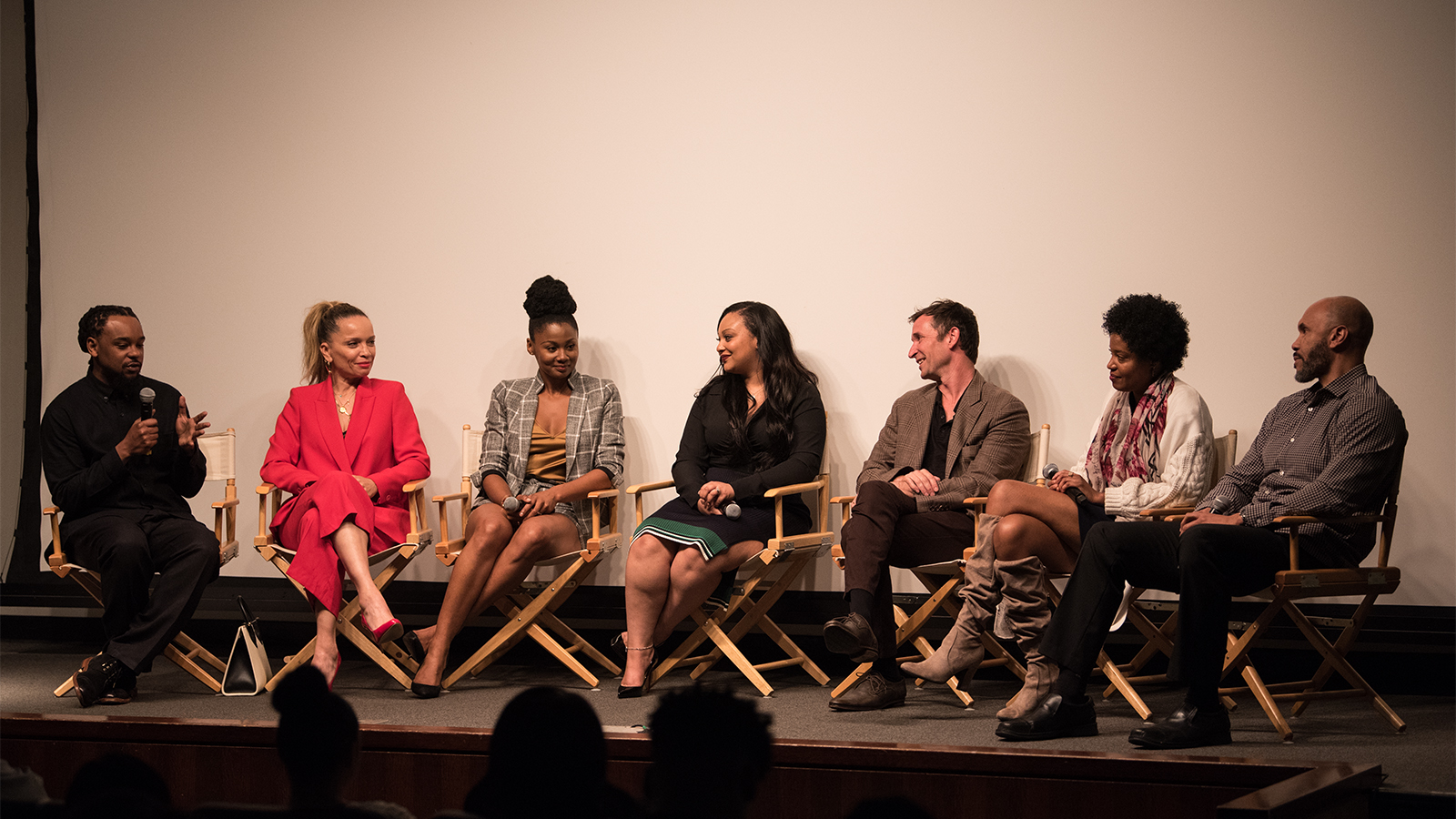‘The Red Line’ panel discusses representation of black creatives in Hollywood

The cast and crew of “The Red Line,” a CBS limited series following three families impacted by the police shooting of an unarmed, black man. The panel highlighted the challenges black creatives in Hollywood face and representation in the industry.
(Daanish Bhatti/Daily Bruin)
By Kennedy Hill
April 26, 2019 3:58 p.m.
One gunshot forever changed the lives of three families in “The Red Line.”
Connected by a crosstown train, the families form the subject of the drama series. The first two episodes of “The Red Line” are set to premiere Sunday on CBS, and UCLA’s African American Studies department offered a free screening of them Thursday at the Fowler Museum’s Lenart Auditorium.
The series, produced by UCLA alumna Ava DuVernay, follows the lives of three families impacted by the police shooting of an unarmed black man, commenting on the race relations present in a socially segregated Chicago.
Following the screening, Marcus Hunter, the chair of the African American Studies department, led a panel comprising leading members of the cast and crew to discuss the challenges that black creatives face in Hollywood.
“One of the major things that we want to do in the department is to provide an experience that is not just about classroom curriculum, but real life,” Hunter said. “(DuVernay) is a black alum of UCLA … and so we were a conduit to bring back a black Bruin and demonstrate what they can do when they’re out in the world.”
In the limited series, 17-year-old Jira Calder-Brennan, played by Aliyah Royale, finds it difficult to be comforted by her surviving, white father Daniel Calder, played by Noah Wyle, after her black father is gunned down. Hoping to find a parent who could relate to her fears as a black woman, Jira searches for her birth mother-turned-politician, Tia Young, played by Emayatzy Corinealdi. Due to its reputation for more conservative programming, director Victoria Mahoney said the CBS network will allow “The Red Line” to share a diverse depiction of marginalized communities with viewers that are typically not exposed to such programming.
“The idea of getting this content in Idaho and Poughkeepsie and Virginia … that was interesting to me because we’re never going to move the needle if we don’t center the story (from all points of view),” Mahoney said.
The Chicago setting, known for its high degree of segregation, plays just as much of a role in the show as the characters do, Mahoney said. The red line is a train connecting the mostly white-populated North side of Chicago to the mostly black-populated South side of Chicago, and Hunter said it serves as a metaphor for the stark divide between the two racial communities. Jessica Jackson, a first-year African American Studies student and attendee, said the show’s portrayal of her hometown is more holistic than the trope-ridden depictions found in many other films.
“I feel like Chicago is immediately corrupt (in media); it’s never in a dual light of (the) real people who live here,” Jackson said. “So for me, this is a really refreshing take.”
Although Chicago’s racialized politics were the show’s focus, a panel including Royale, Wyle, Corinealdi and Mahoney shifted the discourse toward the sparse representation of black filmmakers in Hollywood. As a newcomer to the world of studio television, Royale said being surrounded by a diverse cast allowed her to reach a deeper level of vulnerability needed for her character. Corinealdi said it is rare for black women to hold both a director position and major role in a network television program, and “The Red Line” uses this to add authenticity to the minority characters.
“We get to see what it’s like for a lot of our peers who have that experience more often,” Corinealdi said. “The gist should be more, so then when you do have it, it doesn’t have to feel so special.”
As one of the show’s few leading white characters, Wyle said the script both terrified and moved him. Although he spent more than a decade on the Emmy-winning drama “ER,” Wyle said “The Red Line” has been one of his most emotionally taxing roles due to its controversial and socially relevant subject matter. Wyle said the story’s racialized nature required him to form a sense of trust with his cast and crew, and allowed him to recognize the prejudices faced by minority communities in Hollywood.
“I was on the set just quiet, for the first time in 25 years … (and) I got to sit and watch how a woman director is disrespected,” Wyle said. “What I have wanted to pretend does not exist … exists whether I’m choosing to look at it or not, and I just chose to start looking at it.”
Although a string of recent movies, such as “The Hate U Give,” have delved into the same topic, Mahoney said a season of television offers a deeper analysis of individual arcs and opposing viewpoints than can be found in a two-hour film. “The Red Line” has reworked the narrative of the mistaken shooting for its eight-episode format through special attention to the nuance of racial tension and a balance of seemingly opposing characters, Mahoney said.
“People say things to me like (‘Every story has been told’), but I think that it hasn’t (been told) because (they) never told it from my eyes,” Mahoney said.

